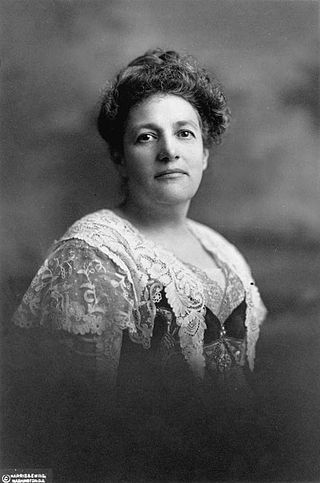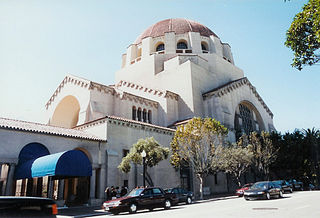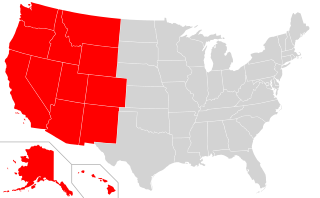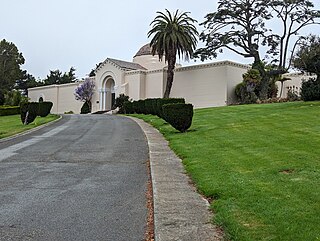Related Research Articles

The California gold rush (1848–1855) was a gold rush that began on January 24, 1848, when gold was found by James W. Marshall at Sutter's Mill in Coloma, California. The news of gold brought approximately 300,000 people to California from the rest of the United States and abroad. The sudden influx of gold into the money supply reinvigorated the American economy; the sudden population increase allowed California to go rapidly to statehood in the Compromise of 1850. The gold rush had severe effects on Native Californians and accelerated the Native American population's decline from disease, starvation, and the California genocide.

Florence Kahn was an American teacher and politician who in 1925 became the first Jewish woman to serve in the United States Congress. She was only the fifth woman to serve in Congress, and the second from California, after fellow San Franciscan Mae Nolan. Like Nolan, she took the seat in the House of Representatives left vacant by the death of her husband, Julius Kahn.

Julius Kahn was a United States Congressman who was succeeded by his wife Florence Prag Kahn after his death. He has been described by the American Jerusalem as "among the most influential Jews in San Francisco—as well as national–civic life, from the middle of the 19th century into the 1930s".

Congregation Emanu-El of San Francisco, California is one of the two oldest Jewish congregations in California, and one of the largest Jewish congregations in the United States. A member of the Union for Reform Judaism, Congregation Emanu-El is a significant gathering place for the Bay Area Jewish community.
The history of California can be divided into the Native American period, the European exploration period (1542–1769), the Spanish colonial period (1769–1821), the Mexican period (1821–1848), and United States statehood. California was one of the most culturally and linguistically diverse areas in pre-Columbian North America. After contact with Spanish explorers, many of the Native Americans died from foreign diseases. Finally, in the 19th century there was a genocide by United States government and private citizens, which is known as the California genocide.
Dallas is the third-largest city in Texas and has one of the largest Jewish communities in the state.

The 19th century saw Jews, like many other people, moving to the American West.
Congregation Am Tikvah is a combined Conservative and Reform Jewish congregation and synagogue located at 625 Brotherhood Way in San Francisco, California, in the United States. The congregation was formed in 2021 as the result of the merger of the Conservative B'nai Emunah and the Reform Beth Israel Judea congregations, with the latter formed in 1969 through a merger of the Conservative Congregation Beth Israel and the Reform Temple Judea. The congregation is affiliated with both the Union for Reform Judaism and the United Synagogue of Conservative Judaism.
Temple Israel is a Reform Jewish congregation and synagogue, located at 5105 North El Dorado Street, in Stockton, California, in the United States. Established in 1850, it is one of the oldest Jewish congregations in California.

Congregation Sherith Israel is a Reform Jewish congregation and synagogue, located in San Francisco, California, in the United States. Founded in 1851 during California’s Gold Rush period, it is one of the oldest synagogues in the United States. In more modern times, the congregation widely known for its innovative approach to worship and lifecycle celebrations. Listed on the National Register of Historic Places, its historic sanctuary building, completed in 1905, is one of San Francisco's most prominent architectural landmarks.

Fred Rosenbaum is an American author, historian and adult educator, specializing in the history of the Jewish community of the San Francisco Bay Area. Rosenbaum has been called a "superb storyteller". He is a founder and the director of Lehrhaus Judaica in Berkeley, California, described as "the largest Jewish adult education center in the western United States".
Mary Ann Magnin (1850–1943) was a Dutch-American businesswoman. She was the co-founder of I. Magnin, an upscale "specialty store" in San Francisco, California.
The history of the Jews in Alaska began before the Alaska Purchase in 1867. Jews from Imperial Russia lived there periodically as fur traders, and a Jewish community has existed since the 1880s. The Klondike and Nome gold rushes attracted Jews to Alaska to seek their fortunes as miners and businessmen and resulted in the first organized Jewish communities. In the Nazi period, Jewish refugee resettlement in Alaska was seriously considered by the government, but after facing backlash, never came to be. Alaskan Jews played a significant role in business and politics before and after statehood, and have included mayors, judges, senators and governors. Today, there are Jews living in every urban area of the state.

The history of the Jews in San Francisco began with the California Gold Rush in the second half of the 19th-century.

Home of Peace Cemetery, also known as Navai Shalome, is a Jewish cemetery established in 1889, and is located at 1299 El Camino Real in Colma, California. The cemetery contains the Emanu-El Mausoleum, owned by and serving the Congregation Emanu-El of San Francisco. It is one of four Jewish cemeteries near the city of San Francisco and it shares an adjacent space next to the Hills of Eternity Memorial Park.
Marysville Cemetery also known as Historic Marysville City Cemetery, is a no longer active city-owned cemetery that was established in 1850, and is located in Marysville, California. Historically this cemetery has been prone to flooding.

The Sonora Hebrew Cemetery, also known as Pioneer Jewish Cemetery, is an inactive Jewish cemetery founded in c. 1851, and located in Sonora, California. This was the first Jewish cemetery in the Gold Rush region.
Marysville Hebrew Cemetery also known as Marysville Jewish Cemetery, and Jewish Cemetery of Marysville, is a no longer active Jewish cemetery founded in 1855 by the Marysville Hebrew Benevolent Society, and is located at the southeast corner of Marysville Cemetery, in Marysville, California. In 1945, the cemetery was abandoned and forgotten; by 1995 it was restored.
Jackson Pioneer Jewish Cemetery, also known as Givoth Olam, is a no longer active Jewish cemetery founded in 1857 by the Congregation B'nai Israel, and is located in Jackson, Amador County, California. By 1921, the cemetery was closed.
The Pioneer Jewish Synagogue was a former Jewish synagogue located in Jackson in Amador County, California, in the United States. Built in 1857, the congregation vacated the building in 1869, and the former synagogue building was demolished in 1948.
References
- "CMIL-mainframe". University of California: Berkeley. August 2008. Archived from the original on April 9, 2009. Retrieved August 4, 2008.
- "Movie Reviews for Birth of a Community: Jews and the Gold Rush, Information and Film Reviews". DVD Movie Reviews. August 2008. Retrieved August 4, 2008.